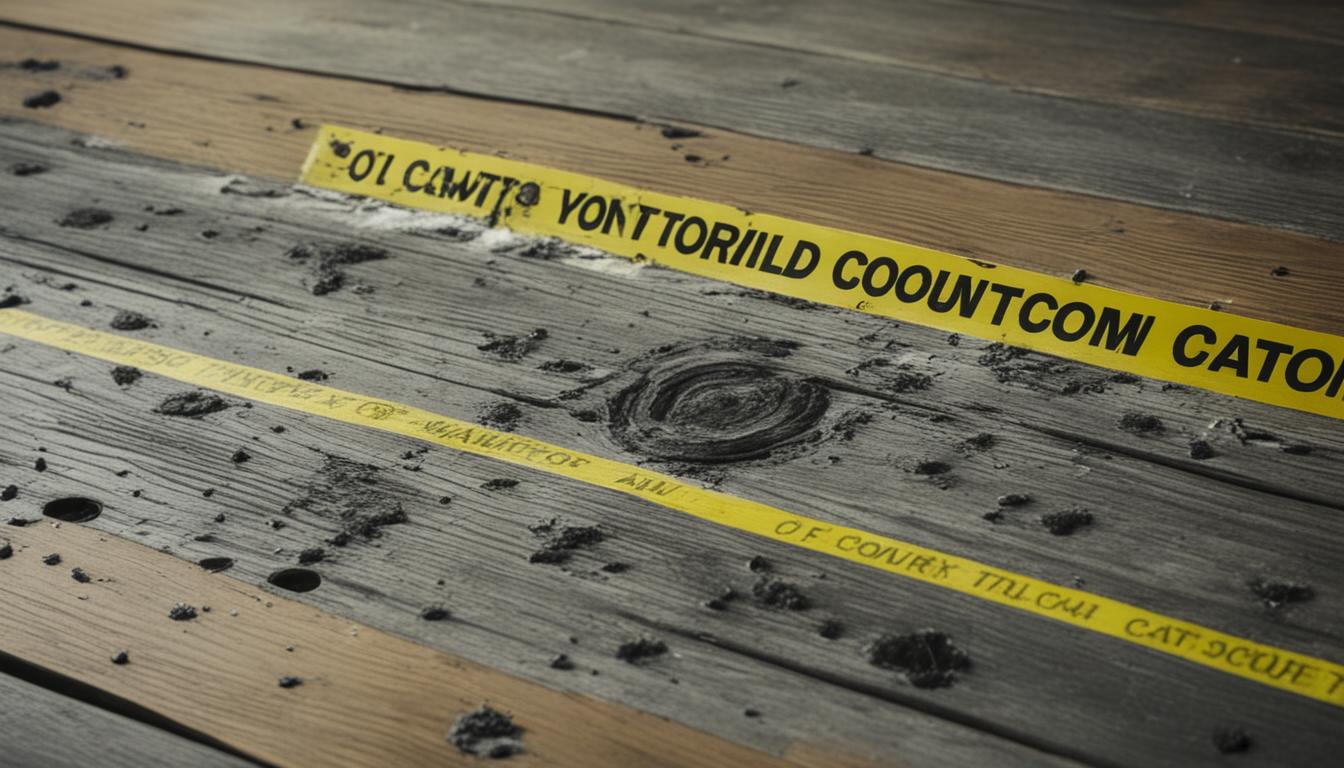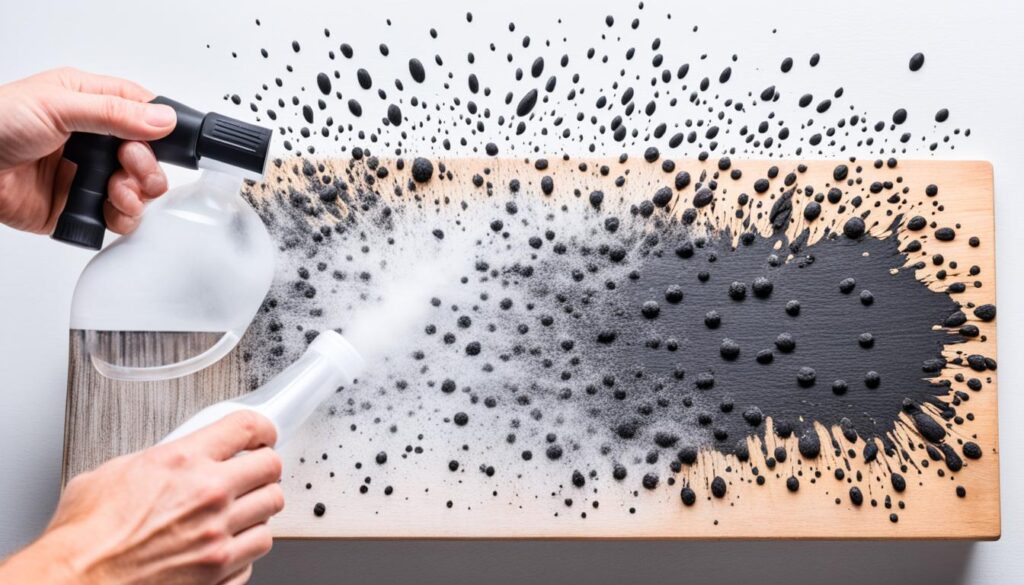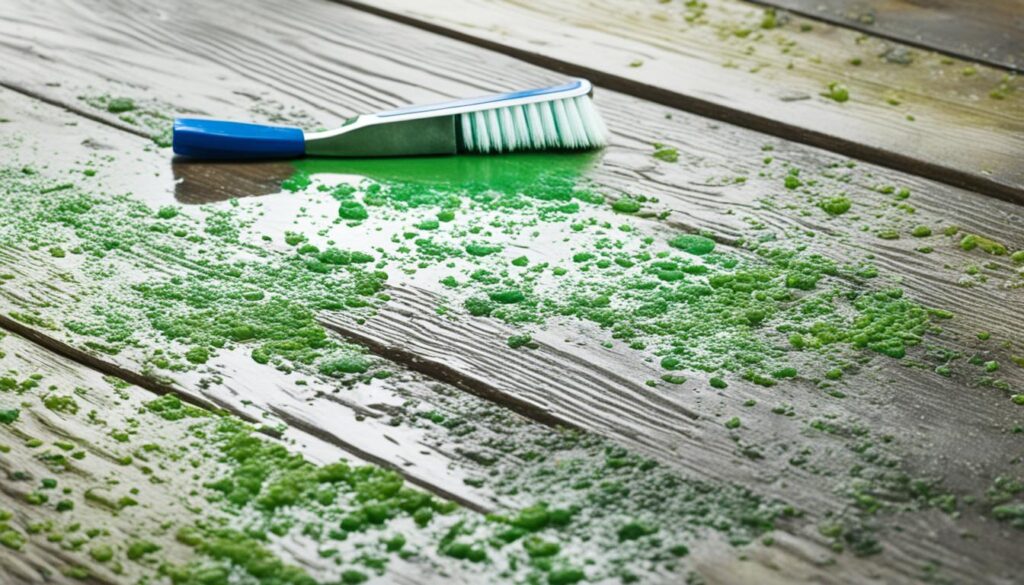
Remedying Mold in Wood – Effective Solutions
If you have noticed mold in your wooden surfaces, it’s crucial to address the issue promptly. Mold not only compromises the structural integrity of wood but also poses health risks. In this section, we will guide you through professional strategies for effectively fixing mold in wood.
Whether you need to know how to fix mold in wood, remove mold from wood, or treat wood mold to prevent future infestations, we have you covered. Learn the best techniques and products to combat mold growth in wooden surfaces.
Key Takeaways:
- Properly addressing mold in wood is essential to protect your health and preserve wooden surfaces.
- Learn how to effectively remove mold from wood and prevent its recurrence.
- Utilize professional strategies and products for mold remediation in wood.
- Promptly address mold-infested wood to avoid structural damage.
- Implement preventive measures to safeguard against future mold growth.
Understanding Wood Mold and its Risks
Before diving into the solutions, it’s essential to understand the risks associated with wood mold. Mold infestations on wood surfaces can lead to structural damage, compromised indoor air quality, and potential health hazards.
Signs of a mold-infested wood:
- Visible discoloration or black spots on the wood surface
- Musty or unpleasant odor coming from the wood
- Soft or deteriorating wood texture
- Presence of water stains or moisture accumulation
The potential hazards of wood mold:
- Structural damage: Mold can weaken the integrity of the wood, leading to warped or cracked surfaces.
- Health risks: Mold spores released into the air can trigger allergies, respiratory issues, and other health problems when inhaled.
- Property value depreciation: Mold-infested wood can decrease the value and appeal of your property.
Timely wood mold repair is crucial to prevent further damage and ensure the safety of your home or business premises. It’s vital to address mold problems promptly and seek professional assistance for effective mold remediation for wood.
Treatment methods for wood mold:
- Physical removal: This method involves physically scrubbing or sanding the mold-infested wood surface to remove the mold. Protective gear should be used to prevent exposure to mold spores during the process.
- Chemical treatment: Certain chemical solutions can be applied to the wood surface to kill and remove the mold. However, it’s crucial to follow safety instructions and use appropriate protective measures when using chemicals.
- Fungicidal treatments: There are specialized fungicidal products available that can effectively kill mold spores and prevent their growth on wood surfaces. These products should be used as directed for optimal results.
- Professional mold remediation: In severe cases or for extensive mold infestations, it’s recommended to enlist the services of professional mold remediation experts. They have the knowledge, experience, and equipment to safely and efficiently handle wood mold issues.
By understanding the risks associated with wood mold and the available treatment methods, you can take the necessary steps to ensure a mold-free and safe environment for yourself and your loved ones.
| Treatment Method | Advantages | Disadvantages |
|---|---|---|
| Physical removal | – Provides immediate results – Removes mold spores from the surface – Can be done without the use of chemicals |
– Requires manual labor and time – May not address hidden mold growth – Risk of spreading mold spores if not done properly |
| Chemical treatment | – Effective in killing mold spores – Can reach hidden mold in porous wood – Provides a protective barrier against future mold growth |
– Requires proper safety precautions – Some chemicals may be harmful to humans and the environment – May require multiple applications |
| Fungicidal treatments | – Specially formulated to target and kill mold – Easy to use – Prevents future mold growth |
– Availability of high-quality products may vary – Requires proper application for maximum effectiveness – May not address underlying moisture issues |
| Professional mold remediation | – Expert assessment and remediation – Comprehensive treatment plan – Minimizes health risks and future mold problems |
– Higher cost – May require temporary relocation during the remediation process – Lengthy process for severe mold infestations |

Effective Strategies for Mold Removal and Treatment in Wood
In this section, we will discuss effective strategies for removing mold from wooden surfaces and preventing its recurrence. Mold growth on wood can be a persistent problem that not only affects the aesthetic appeal of your surfaces but also poses health risks. By implementing these proven techniques, you can ensure the complete removal of mold and long-lasting wood mold prevention.
1. Identifying the Mold
Before you start the removal process, it is important to identify the type of mold present on your wooden surfaces. Different types of molds may require specific treatments for effective removal. While some molds are visible and have a distinct musty odor, others may be hidden beneath the surface. Consider hiring a professional mold inspector to accurately identify the mold and determine the best course of action.
2. Protective Measures
Prior to mold removal, ensure you take appropriate precautions to protect yourself and prevent the spread of mold spores. Wear protective clothing, gloves, and a mask to minimize exposure. Seal off the affected area to avoid contaminating other parts of your home. Open windows and use fans for ventilation during the removal process to reduce the concentration of airborne mold spores.
3. Mold Removal Techniques
When removing mold from wooden surfaces, it is crucial to use effective techniques to ensure complete eradication. Here are some proven methods:
- Dry Brushing: Start by using a dry brush to remove loose mold spores from the surface of the wood.
- Vacuuming: Utilize a vacuum cleaner with a HEPA filter to eliminate mold spores that are not easily swept or brushed away.
- Scrubbing: For visible mold growth, use a scrub brush and a mixture of water and detergent or a specialized mold cleaner to scrub the affected area thoroughly.
- Sanding: In cases where mold has deeply penetrated the wood, sanding may be necessary to remove the mold-infested layers.
- Chemical Treatments: Consider using mold-killing products such as hydrogen peroxide, vinegar, or bleach diluted with water to effectively treat mold-infested wooden surfaces. Follow the product instructions carefully and ensure proper ventilation during application.

4. Preventive Measures
After successfully removing mold from wooden surfaces, it is crucial to implement preventive measures to inhibit future mold growth. Here are some best practices:
- Maintain Proper Ventilation: Ensure adequate airflow by opening windows and using fans in areas prone to high humidity or moisture.
- Control Moisture Levels: Regularly inspect and repair any leaks or sources of water damage, as excess moisture promotes mold growth. Use dehumidifiers in damp areas.
- Proper Insulation: Ensure that your home is properly insulated to prevent condensation and moisture buildup in walls and ceilings.
- Regular Cleaning: Regularly dust and clean wooden surfaces to prevent the accumulation of dirt, dust, and organic matter that can contribute to mold growth.
By following these effective strategies, you can successfully remove mold from wooden surfaces and prevent its recurrence. Remember that mold remediation is essential for maintaining a healthy living environment and preserving the longevity of your wooden structures.
Conclusion
In conclusion, by following the professional strategies outlined in this article, you can successfully tackle mold in wood. It is crucial to address mold on wood promptly to prevent further damage and potential health risks. Implementing preventive measures is equally important to safeguard your health and preserve the integrity of your wooden surfaces.
Remember, proper mold removal from wood requires the use of effective techniques and products. Seek professional assistance if necessary, to ensure thorough and safe remediation. Stay proactive by regularly inspecting and maintaining your wooden surfaces, as prevention is key in avoiding mold infestation.
If you reside in the Miami area and require expert mold assessment services, we recommend contacting Fix Mold Miami. With their extensive experience in mold remediation, they can provide comprehensive solutions tailored to your specific needs. Reach out to them today at 305-465-6653 for professional assistance.




